Remember when I said I thought the bye rounds were okay last week?
Well, fair to say they’re only tolerable when there’s good footy on. The past four days have seen one ugly, soul-sucking contest after another, from Thursday night’s sloppy Richmond win over Port Adelaide in front of twelve people at the MCG, to GWS treating North Melbourne with disdain on Sunday arvo.
At least Fremantle’s win over Hawthorn was a captivating, hard-fought affair, while Queen’s Birthday Monday should be a beauty between Melbourne and Collingwood. But little wonder that so many off-field stories got the bulk of the attention this weekend – there was nothing on-field to get us talking!
So from Bailey Smith confirmed to be exactly the sort of dude we kind of assumed he was anyway, to drama over concussions, to a last-gasp hurdle for Tasmania’s AFL entry, let’s dive in!
1. The Bailey Smith scandal couldn’t have been handled better
I’ll acknowledge my Bulldogs bias here up front – but from player, to club, to league, I don’t think there was much that could have been done better out of this weekend’s Bailey Smith scandal.
The images of Smith began to circulate on Saturday morning; the story broke shortly after; by mid-afternoon, both the Bulldogs and Smith had released a joint statement putting everything out in the open, apologising for their conduct and stating their intent to tackle it head-on.
I’ve seen some criticism floating around that Smith is ‘only sorry he got caught’ or is hiding behind a mental health defence, which has reportedly been used by players in the past to avoid suspensions for drug infractions.
There’s no real way to respond to either of these, but in my eyes, the first comes in bad faith from already assuming the worst of any player making a public admission of mental health struggles – which Smith had been open about many months before these photos were taken – and the second from a misreading of the 21-year old’s statement.
There is clearly work to be done by the AFL into combatting player drug use. The old ‘three strikes’ policy basically gave players two free goes at taking whatever they pleased, and naturally only one was ever suspended for a third infraction. There also remains a loophole that players who self-report can avoid recording a strike on one occasion.
I’d also argue that allowing anonymity for players on early strikes is problematic: for an issue as obviously serious as drugs in the game, a public naming and shaming at least spurs the clubs and the league to act, as the Bulldogs have swiftly done in the case of Smith.
But in reality, the league and the clubs can only do so much. When you get a bunch of twentysomething males, give them a six- or even seven-figure income and plenty of time off during the summer, bad decisions are going to be made.
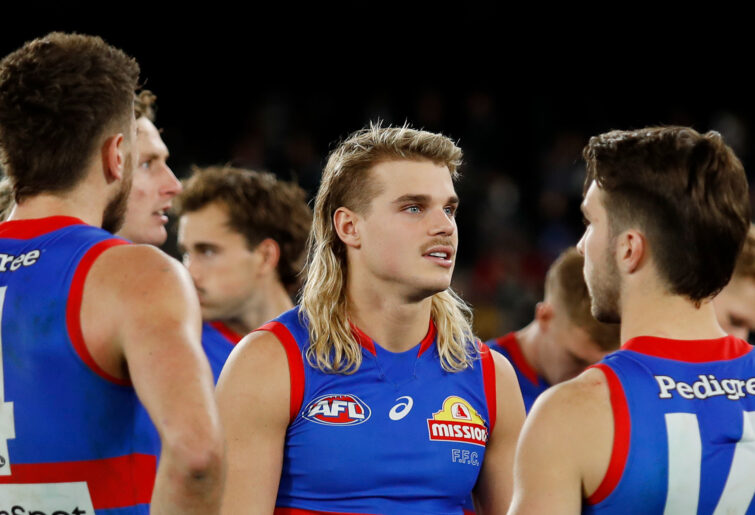
Bailey Smith of the Bulldogs looks dejected after a loss. (Photo by Dylan Burns/AFL Photos via Getty Images)
Every code has this problem – the Melbourne Storm had their infamous ‘white powder’ scandal late last year – and there isn’t any concrete evidence that drugs are more rife among elite, high-paid athletes than in the community at large.
Thus, the biggest step the AFL community needs to make in regards to the modern player, including Smith, is improving support networks for all players both through and post their playing careers to ensure they get the help they need.
Mistakes there seem to be the catalyst for former St Kilda player Sam Fisher’s spiral down to a recent serious drug-trafficking charge: Nick Riewoldt, one of the most vocal AFL figures on the issue, spoke about the Players Association being only ‘reactive’ when it came to Fisher’s case, and lamented the lack of available support once players move on from the industry.
“The AFL will concede and the AFL Players Association will concede a players’ transition out of the game is the biggest issue facing the game,” Riewoldt said on Fox Footy only a few weeks ago.
“Players are paid really well, they have opportunities available to them as they go through the game, but along the line it is not working.
“Too many players are finding themselves post-career… not at the level it should be, and we can do more. I think the AFLPA, in particular, need to champion and take the lead on this cause to stop these situations occurring.”
West Coast’s infamous club drugs crisis of the mid-2000s, by all accounts, stemmed from the club’s unwillingness to nip it in the bud before it got out of control – and 15 years on, many players are still bearing the effects. Well, if Smith’s public shame isn’t a catalyst for the Dogs to get their act together and do everything to address it, then nothing will be.
The Bulldogs, as they should, have stood by Smith, and have vowed to give him the help and support he needs. He’s done something idiotic, and he’s paying the price. It seems likely that a suspension of two-to-four weeks is coming, and he’ll deserve the whack: the damage to his reputation and marketability off the field will take much longer to fix.
But short of driving him out of the game or handing him a monstrous ban to try and make an example of him to the rest of the league – which probably wouldn’t work and would surely only do more harm than good in the case of Smith (not unlike Jesse Pinkman’s parents kicking him out of his house in Breaking Bad) – there’s not much else to do other than to give a young man every possible opportunity to turn his life around.
He deserves the chance to do that now.
2. AFL must take concussion out of its clubs’ hands
“If anyone has got a challenge on that and they feel more qualified than Mark Fisher, who is a 25-year AFL doctor, feel free. But I think you want to be really sure that you’re not trying to make calls from outside the fence when you’ve got no knowledge.”
Those are Ken Hinkley’s comments in his post-match press conference after Port Adelaide’s decision to allow Zak Butters and Tom Jonas to return to the field without a 15-minute concussion test late in their tense loss to Richmond was questioned.
He’s not wrong: the doctor at the centre of the scene is clearly going to know more about Butters and Jonas’ situation than the average punter watching on TV. The problem, though, is trust.
We take it for granted that club doctors are pillars of virtue whose integrity can never be questioned. But mistakes can, and do, happen. The Power themselves were fined $20,000 (half suspended) for breaching concussion rules after sending Hamish Hartlett back on too quickly in 2016. The Western Bulldogs let Clay Smith keep playing after rupturing his ACL in 2015, only to watch him collapse again minutes later.
Add to that that no player is ever going to immediately rule themselves out of a tight match – I remember Nick Riewoldt saying early last year that he’d have gone to court if he had been forced to miss a grand final through the AFL’s new mandatory concussion protocols – and you’ve got an immensely fraught situation for even the most experienced medico. It’s a recipe for disaster.
Given that, appointing independent doctors to monitor matches, rather than leaving concussion in the hands of the clubs, is the way forward. The AFL should have learned by now that the stakes are too high to leave the current system in place, a system that can easily be rorted in high-pressure situations. Look at what happened to the medical substitute: starting out as an AFL initiative to enable teams to take concussion seriously by giving them the chance to sub players out after head knocks was quickly warped by the clubs and is now for all intents and purposes a coaching tactic.
It’s not even fair to single out Port for this: in the same game, Dustin Martin copped a knee to the head from Jack Riewoldt, and looked worryingly dazed for a number of minutes before returning to the field.
Of course, an independent ruling will create problems of its own: the NRL’s set-up where a doctor monitors the match from ‘the bunker’ has been criticised for its heavy-handed approach, with many players mystified as to why they’re being forced to undertake head injury assessments after minor incidents.
But with so much mystery still surrounding concussion and its long-term effects, those drawbacks pale in comparison to the current risk of allowing a concussed player to go through what Butters did on Thursday night: having been cleared to return, he was quickly dumped in a bruising tackle. Imagine if he’d actually been concussed .
Former player Will Schofield sums up the state of mind of players perfectly in his piece for Code Sports calling for an independent doctor to take control of concussion.
“Players need to be protected from themselves in regards to their playing future. Players, especially young ones, will always want to push through what they are feeling and find a way to keep playing, whether that’s game day or during the week,” Schofield writes.
“The players’ personal relationship with team doctors does have an impact here and we would be naive to think otherwise. An independent expert fixes this.
“The league has a duty of care to its players and this is a way to achieve it.”
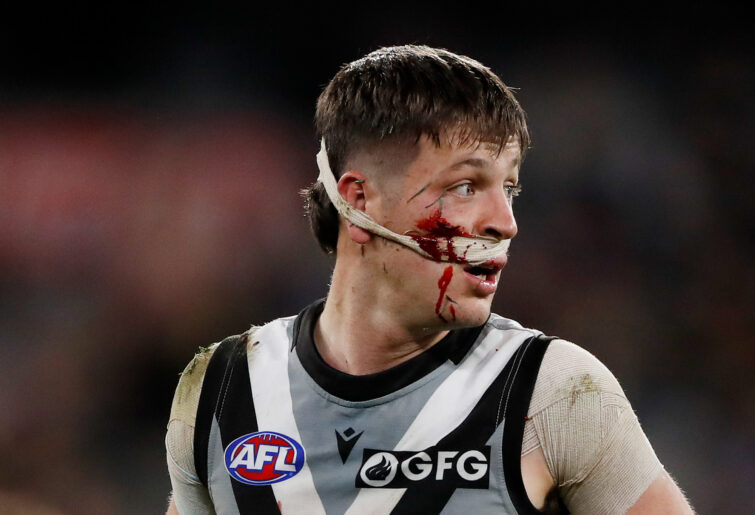
Zak Butters of the Power is seen bleeding from the face. (Photo by Dylan Burns/AFL Photos via Getty Images)
3. The AFL’s crowd crisis has been coming for years
Ask anyone who follows the AFL what has caused the sizeable drop in crowd numbers in 2022, and you’ll probably get a different answer.
Ticket prices are too high. The blaring music at the game is too loud. It’s those darned umpires. People are still worried about COVID.
There are a million different explanations you’ll get: I posit that all of them have something to do with it, but the whole story is more complicated than all that.
Tickets have been prohibitively expensive for years, music at the game for a decade, and umpiring decisions have caused footy fans grief since time began. What has changed is the fact that many of us rusted-on supporters got a taste of watching games on television during the COVID-19 pandemic – and found it wasn’t so bad after all.
No more queueing for overpriced food – just get a snack from the kitchen. No being crammed in like sardines on a freezing night to watch your team get flogged – now stretch out on the couch, turn the heater on and maybe switch off halfway through the last quarter if it’s getting really grim.
High-definition TV and every game being broadcast live and at a reasonable price for most has never made it more appealing to just stay at home. I don’t have any evidence for this point, but I’d wager an increase of people working from home since the pandemic began is probably one of the reasons Richmond’s crowd attendance on Thursday night was so low. In the past, fans working in the city would have simply hopped on a tram over to the MCG; now, they’d have to come all the way into the city.
No doubt umpiring annoyance, ticketing frustration and a whole bunch of other mini-grievances all AFL fans have at the way things are hasn’t helped matters; but for me the bigger factor is that a convenient alternative has been found for many, and new routines forged in the 18 months various parts of our country, particularly Melbourne, were locked down.
Other sports arrived at this epiphany a long time ago: the NRL, for instance, has long had a problem with crowds, not least because it’s a far more compelling product for TV. You don’t miss much about the game watching on a screen than you do at a match. The same goes for cricket: 90 overs at the ground is far less palatable for many than being able to half-watch it in the background while doing other things at home, racing over to see the replay when a wicket falls.
That’s bad news for the AFL: it won’t be an easy fix to get people back through the gates. It’s not a matter of getting rid of the music, reverting the rules back a decade and letting kids in free during winter. It’s about convincing people that forking out their hard-earned to go to a game is a better alternative than the freedom and comfort of watching at home.
Which will take time. It might even be impossible.
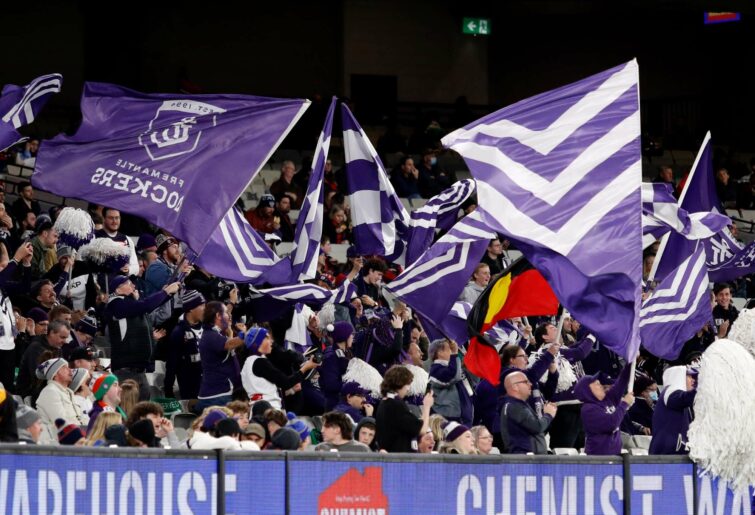
(Photo by Dylan Burns/AFL Photos via Getty Images)
4. McVeigh’s innovations a Giant step forward for GWS
Who knows whether Mark McVeigh will get the GWS coaching job full time – history says he won’t. But in his first three matches, the interim boss has barely put a foot wrong.
Yes, his two wins have come against the barely AFL-standard West Coast and North Melbourne, with a narrow loss to an out-of-touch Brisbane sandwiched in between. But far from simply going through the motions, McVeigh has demonstrated a willingness to put his own stamp on the Giants that should have other clubs watching intently.
Since taking the reigns, the Giants have been the AFL’s number one side in attacking through the corridor, leading to comparisons to the famed ‘Orange Tsunami’ of old. It’s been a breath of fresh air for a side that became stagnant and risk-averse in the last few years under Leon Cameron.
It would be natural for an interim coach to want to play the best possible side to try and maximise their chances of getting the top job, but McVeigh has been willing to further develop the club’s youth. James Peatling, Jacob Wehr and Jake Riccardi were seldom given opportunities under Cameron, but all have grabbed the opportunity with both hands now. Riccardi in particular shone on Sunday with three goals against the Kangaroos. Tanner Bruhn, too, relished the extra responsibility of midfield minutes.
Then, there’s the rejuvenation of the older brigade. Stephen Coniglio is playing his best footy since 2019, and it’s no secret that it has come since returning to a full-time role in the middle. Harry Himmelberg has exemplified the Giants’ turnaround, having shifted almost seamlessly into defence and quickly becoming one of the club’s leading distributors.
The Giants will get bigger tests than the Eagles and Kangaroos: one awaits this week, in the form of a battling Western Bulldogs. But surely the hierarchy will be at least considering McVeigh as the full-time answer in 2023 – especially if they can’t persuade Alastair Clarkson to join the fold.
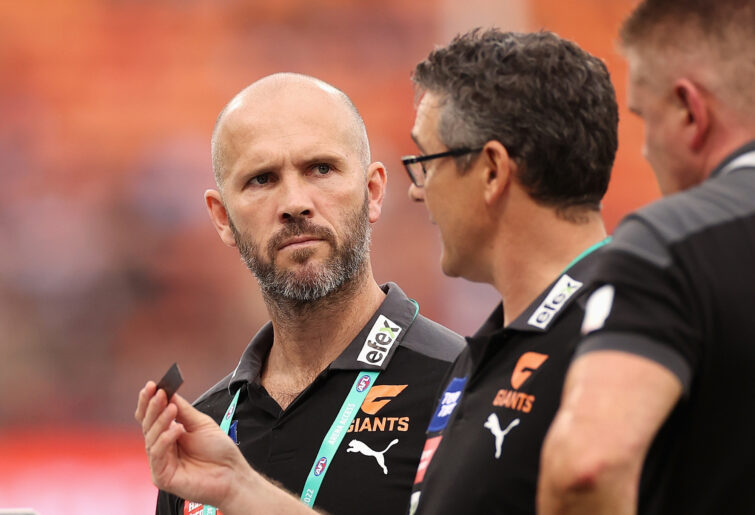
Giants head coach Leon Cameron and assistant coach Mark McVeigh talk. (Photo by Cameron Spencer/AFL Photos/via Getty Images )
5. The North-bashing has officially lost the plot
Sports journalist Ronny Lerner has written some fine articles in the past, but his latest on North Melbourne’s supposed brand change away from the ‘Shinboner Spirit’ on ZeroHanger isn’t one of them.
It’s probably a bit hypocritical considering the nature of The Roar, but my first thought reading it was that it was unsurprising nobody in the mainstream media had touched this non-story first. Then The Age ran an op-ed on it a day later, and boom, it was a serious issue.
“They’re in a mess now, but they won’t get out of it by some sort of Orwellian self-cancellation,” Greg Baum writes.
“Fudging their identity may or may not widen their appeal. It didn’t last time. But it also loosens their moorings. If the Kangaroos are not North Melbourne, they could be anywhere in Australia. That includes Tasmania.”
One thing I’ve hated about the treatment of North Melbourne in the media these past few years – and I acknowledge off the bat that this website has its own chequered history when it comes to this – is that the criticism is basically a vicious circle. When Caroline Wilson says on Footy Classified that talk of relocating the club to Tasmania ‘won’t go away’… well, of course it won’t, because you bring it up every other week!
Lerner’s headline sums this point up nicely: “Kangaroos facelift raises more questions over club’s future”. It’s the same circular reasoning as Wilson’s: it will only ‘raise more questions’ because the people writing about it are also the ones doing the questioning.
Without the backstory of North being talked about as a relocation target for the best part of three decades, this branding push is an absolute non-story. North Melbourne shying away from the ‘Shinboner spirit’ moniker with younger fans means nothing… unless, of course, you’re looking for any sign whatsoever that the club is losing its grip on its heritage, thus making it primed for relocation.
Put it this way: when St Kilda moved from their traditional Moorabbin base to Seaford, or Carlton at last stopped playing at Princes Park – both far more seismic shifts than at North Melbourne – was this a sign that the club was on the rocks, giving up their heritage and raising questions about their future?
As for the ‘Orwellian self-cancellation’ jab from Baum; I’d argue it’s not hiding their history so much as putting out a different message for the future. And how does the slightly toned-down use of one single word ‘loosen their moorings’… unless you’re working from the base that those moorings are already loose?
Lerner’s article appears to suggest that the move by the club is to distance itself from its heritage, when it seems to be more to do with a reasonable theory that young kids probably don’t have much of an idea what a ‘Shinboner’ is, or that it’s a reference to the old North Melbourne abbatoirs that probably wouldn’t carry much of a meaning for fans who only remember the club playing at Marvel Stadium.
The article also reports that the Roos’ internal communications state: “Internal culture and to existing fans base, we refer to the Shinboner Spirit.” Doesn’t sound like a club keen to move on from its history; rather, a club that recognises it needs to broaden its appeal to new fans in order to bring in more members, for which it gets lambasted for frequently.
North, especially a struggling North, are the easiest of targets for the media to sink the boots in, because any tidbits of information become a story. Jason Horne-Francis liking an Instagram fake trade of him to Port Adelaide? Boom, a story.
For me, this yarn – and The Age’s response to it – is doing nothing more than trying to suggest fan alienation from this new move akin to the widely-criticised renaming as the ‘Kangaroos’ in the late 1990s, which really doesn’t seem to have happened. And why would fans be annoyed at this most minor of tweaks?
Sink the boots into North if you want – they’re giving us enough ammunition with their efforts on the field, no doubt. Hold the coaching staff, the recruiters, the development staff, the players, to account when they stink it up. Hell, I’m about to do it in my next point.
But all this sort of reporting does is punish the fans, the ones that do admirable things like rock up to Marvel Stadium on a Sunday afternoon to watch their team get pumped. They’re the true innocents in all this.
And if we’re going to resort to hyperbole, exaggeration and innuendo, then the plot has officially been lost.
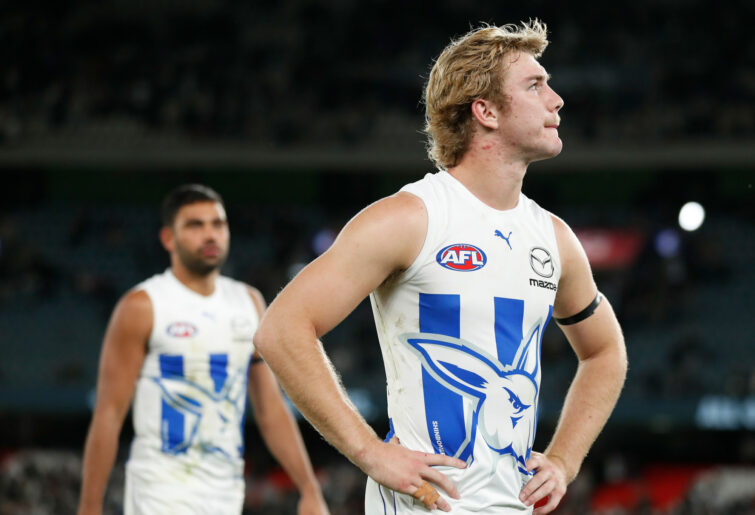
(Photo by Michael Willson/AFL Photos via Getty Images)
6. Please, Jason Horne-Francis, don’t be a sniper
I was blunt with Trent Cotchin a few weeks ago, and I’ll be blunt again here with Jason Horne-Francis. Be better.
The number one draft pick’s late swinging arm on Josh Kelly during the Roos’ thumping loss to GWS was completely unnecessary, potentially dangerous, and the textbook case for dirty play.
It’s not the first time he’s flirted with the line, either: his famous exchange with Carlton’s Jack Silvagni a few weeks ago took the focus off another late hit from Horne-Francis that led to Silvagni’s ‘your club is s–t’ sledge.
There are plenty of positives for Horne-Francis this season: he wears his heart on his sleeve, goes in hard at the ball and has already provided a number of highlights in what has been a dark year for the Roos. This idea that he wants out because he’s put off his contract talks is ridiculous – all I saw on Sunday was a young bloke trying to cope with failure on both a personal and team level for probably the first time in his life, and understandably struggling with it.
He’s not the first young player, and nor will he be the last, to take his aggression a step too far. But the club needs to make it clear that he needs to cut out the crap.
He’ll probably get a week for the hit because Kelly got up and played out the game. I’d be fine with him getting another on top of that purely for the look.
There’s no doubt Horne-Francis is frustrated with where the Roos are at the moment: a player as talented as him has likely never been in a side as uncompetitive as North are at the moment.
I’d have been fine with him venting that anger with solid hip-and-shoulder on Kelly, a player the Roos had clearly aimed to put off his game all afternoon; hell, even a late tackle would have been a better way to fly the flag.
But nothing good comes of a swinging arm like that; the action itself isn’t that distinct from Andrew Gaff’s on Andrew Brayshaw all those years ago, which left the Docker with a broken jaw.
Horne-Francis is 12 games into what will presumably be a long and decorated career. He’s got plenty of time to get this stuff out of his game.
But he’d better start doing it soon, because just ask Cotchin how hard it is to shake the ‘sniper’ tag. Once you cop it, it tends to be for life.
Random thoughts
– Brisbane are very lucky the Saints were too injured to take advantage of them naming Darcy Fort as medi-sub.
– Under-the-radar recruit of the year nomination: Jordan Clark has not put a foot wrong since getting to Freo.
– I reckon we’re 12 months away from Liam Baker entering Shane Edwards ‘so-underrated-he’s-actually-not-anymore’ status.
– Has Dylan Grimes returned Robbie Gray to Alberton yet?
– Anti-gambling ads should start running pictures of Jaidyn Stephenson. Has been a different player since that ban in 2019 – and in the worst way possible.
– Calling it now – in two years’ time, getting 15 games into Ben Hobbs will be the biggest positive out of Essendon’s year.

































































































